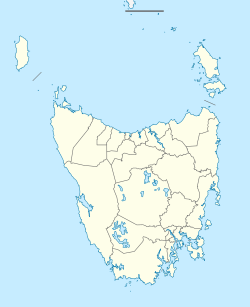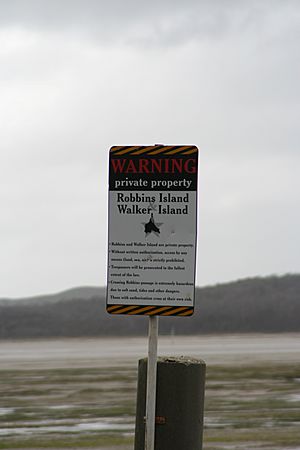Robbins Island (Tasmania) facts for kids
|
Location of Robbins Island in the Bass Strait
|
|
| Etymology | Charles Robbins |
|---|---|
| Geography | |
| Location | Bass Strait |
| Coordinates | 40°41′24″S 144°54′36″E / 40.69000°S 144.91000°E |
| Area | 9,900 ha (24,000 acres) |
| Area rank | 7th in Tasmania |
| Administration | |
|
Australia
|
|
| State | Tasmania |
| LGA | Circular Head Council |
| Additional information | |
| Time zone | |
| • Summer (DST) | |
| Privately-owned | |
Robbins Island is a large island off the northwest coast of Tasmania, Australia. It covers about 9,900 hectares (that's like 24,463 acres!). The island is in the Bass Strait and is separated from the Tasmanian mainland by a very tidal area called Robbins Passage. It sits just south of Walker Island.
Robbins Island is the seventh largest island in Tasmania. It is also the biggest privately owned island in Tasmania. Over the years, Robbins Island has had different owners, and it is still privately owned today.
Contents
History of Robbins Island
Before Europeans arrived, Robbins Island was home to the Parperloihener band of the indigenous North West tribe. Their land stretched from Table Cape to the western side of Macquarie Harbour.
How the Island Got Its Name
On November 23, 1802, a British officer named Charles Robbins was sent on a ship called Cumberland. He was sent by Governor King to stop a French explorer, Nicholas Baudin, from claiming Van Diemen's Land (which is now Tasmania) for France. Baudin had shared his plans to colonize the land at a party. Governor King did not want the French to take over.
Robbins successfully convinced Baudin to give up his plans for French settlement. Later, in 1804, Robbins saw the island that is now named after him. He spotted it during a trip to retrieve some Spanish ships.
Changes in Ownership and Life on the Island
In 1826, after the British took over Tasmania, a group of businessmen in England formed the Van Diemen's Land Company. They wanted to use land in Tasmania to raise sheep for wool. This wool would then be sent to British factories. The company was given control of about 250,000 acres of land, including Robbins Island. This land became private property.
During the 1820s to 1840s, there were many conflicts between the European settlers and the North West tribe. These conflicts became very violent. Sadly, almost all Indigenous people from the Tasmanian mainland, including the Parperloihener band from Robbins Island, were moved to a reserve on Flinders Island in 1835.
In 1850, a man named David Howie started renting part of the island for farming.
Island Features and Wildlife
Robbins Island has several interesting natural features:
- Cape Elie is the most eastern point of the island.
- Guyton Point is located on the northeastern part of the island.
- Mosquito Inlet is an estuary (where a river meets the sea) northwest of the island. It covers about 674 hectares. Four bird species often rest here: the eastern curlew, masked lapwing, pied oystercatcher, and sooty oystercatcher.
- Five Islets are small islands northwest of Robbins Island. Fairy terns and pied oystercatchers build their nests here. Many migratory birds also visit, such as the great knot, red knot, bar-tailed godwit, and grey plover.
- Bird Point is also northwest of Robbins Island. Many bird species rest here permanently, including fairy terns, little terns, Caspian terns, and crested terns. It's also a popular spot for migratory birds like grey-tailed tattlers, red-necked stints, and ruddy turnstones.
What's Happening on the Island Today?
Before the 1850s, the island was used for grazing animals, mainly for wool. In 1873, William B. Reid leased the island for 43 years. He farmed there and made dairy products. He also used native animals for hunting.
In 1916, Bill and Norah Holyman bought the island and used it for raising sheep. They sold the island in 1958. In 1961, H. E. Hammond became the owner, and his family still owns it today. His family, including Keith and John Hammond, now raise special wagyū beef cattle on Robbins Island. This beef is even sent to Japan!
Close to the island, the commercial aquaculture industry from Circular Head harvests rock lobster and abalone from the waters.
There have been plans to build a wind farm on the island. A new proposal for a very large wind farm was submitted in January 2022.
See also



